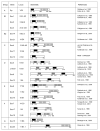Control of cell fate and differentiation by Sry-related high-mobility-group box (Sox) transcription factors
- PMID: 17625949
- PMCID: PMC2080623
- DOI: 10.1016/j.biocel.2007.05.019
Control of cell fate and differentiation by Sry-related high-mobility-group box (Sox) transcription factors
Abstract
Maintain stemness, commit to a specific lineage, differentiate, proliferate, or die. These are essential decisions that every cell is constantly challenged to make in multi-cellular organisms to ensure proper development, adult maintenance, and adaptability. SRY-related high-mobility-group box (Sox) transcription factors have emerged in the animal kingdom to help cells effect such decisions. They are encoded by 20 genes in humans and mice. They share a highly conserved high-mobility-group box domain that was originally identified in SRY, the sex-determining gene on the Y chromosome, and that has derived from a canonical high-mobility-group domain characteristic of chromatin-associated proteins. The high-mobility-group box domain binds DNA in the minor groove and increases its DNA binding affinity and specificity by interacting with many types of transcription factors. It also bends DNA and may thereby confer on Sox proteins a unique and critical role in the assembly of transcriptional enhanceosomes. Sox proteins fall into eight groups. Most feature a transactivation or transrepression domain and thereby also act as typical transcription factors. Each gene has distinct expression pattern and molecular properties, often redundant with those in the same group and overlapping with those in other groups. As a whole the Sox family controls cell fate and differentiation in a multitude of processes, such as male differentiation, stemness, neurogenesis, and skeletogenesis. We review their specific molecular properties and in vivo roles, stress recent advances in the field, and suggest directions for future investigations.
References
-
- Aoki Y, Saint-Germain N, Gyda M, Magner-Fink E, Lee YH, Credidio C, Saint-Jeannet JP. Sox10 regulates the development of neural crest-derived melanocytes in Xenopus. Developmental Biology. 2003;259:19–33. - PubMed
-
- Barrionuevo F, Bagheri-Fam S, Klattig J, Kist R, Taketo MM, Englert C, Scherer G. Homozygous inactivation of Sox9 causes complete XY sex reversal in mice. Biology of Reproduction. 2006a;74:195–201. - PubMed
Publication types
MeSH terms
Substances
Grants and funding
LinkOut - more resources
Full Text Sources
Other Literature Sources
Research Materials
Miscellaneous




